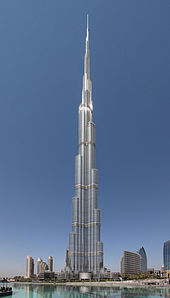
The architecture of the United Arab Emirates has undergone dramatic transformation in recent decades, from operating as a collection of fishing villages to a global business hub known for its innovation and dynamism.[1] Between the 1960s and 1970s, architecture in the United Arab Emirates (UAE) remained solely traditional, with narrow alleys and windtower houses still in use,[2] reflective of a strong Bedouin heritage. Architecture is influenced by elements of Islamic, Arabian and Persian culture.[3]
In 1959, Sheikh Rashid bin Saeed Al Maktoum, the former ruler of Dubai, commissioned British architect John R Harris to create the city's first town plan. Soon afterwards, Harris began completing commissions for low- and mid-rise buildings that expressed the city's modern ambitions. These buildings often included facades that kept the buildings partially cooled with by taking advantage of shadow.[4] Harris's tower for Dubai World Trade Centre was the tallest building he proposed for the city, and it was the city's tallest tower for many years. Completed in 1979, it utilized various techniques to reduce energy consumption in the tower, including a double facade that receded glazing behind an outer facade.[5] Architectural glazing, nevertheless, would prevail in Dubai and in Abu Dhabi. Around the same time as the World Trade Centre was completed, other architects began making more expressive use of exposed glass curtain facades, for example the BCCI bank buildings designed by the British firm Fitzroy Robinson and Partners. Glass curtain walls are now a prevailing architectural element throughout the Persian Gulf.[6] In less commercial areas, Emirati architecture continues to heavily reflects the custom and traditional lifestyles of the native people. While these building materials might be considered simple, that does not mean that these buildings are also highly reliant about artificial cooling and other environmentally unsound practices.
- ^ "Architecture in Dubai | Frommer's". frommers.com. Retrieved 2019-05-31.
- ^ Room, The CAD (2016-09-27). "Traditional Architecture in the UAE | BIM UAE". The CAD Room. Retrieved 2019-05-31.
- ^ "Islamic arts - Music". Encyclopedia Britannica. Retrieved 2019-05-31.
- ^ Reisz, Todd (2021). Showpiece city: how architecture made Dubai. Stanford studies in Middle Eastern and Islamic societies and cultures. Stanford, California: Stanford University Press. ISBN 978-1-5036-1386-7.
- ^ Reisz, Todd (2016-05-16). "Story of cities #43: how Dubai's World Trade Centre sold the city to the world". The Guardian. ISSN 0261-3077. Retrieved 2023-12-18.
- ^ "Metamorphosis. The Continuity of Change". Issuu. 7 September 2018. Retrieved 2019-05-31.